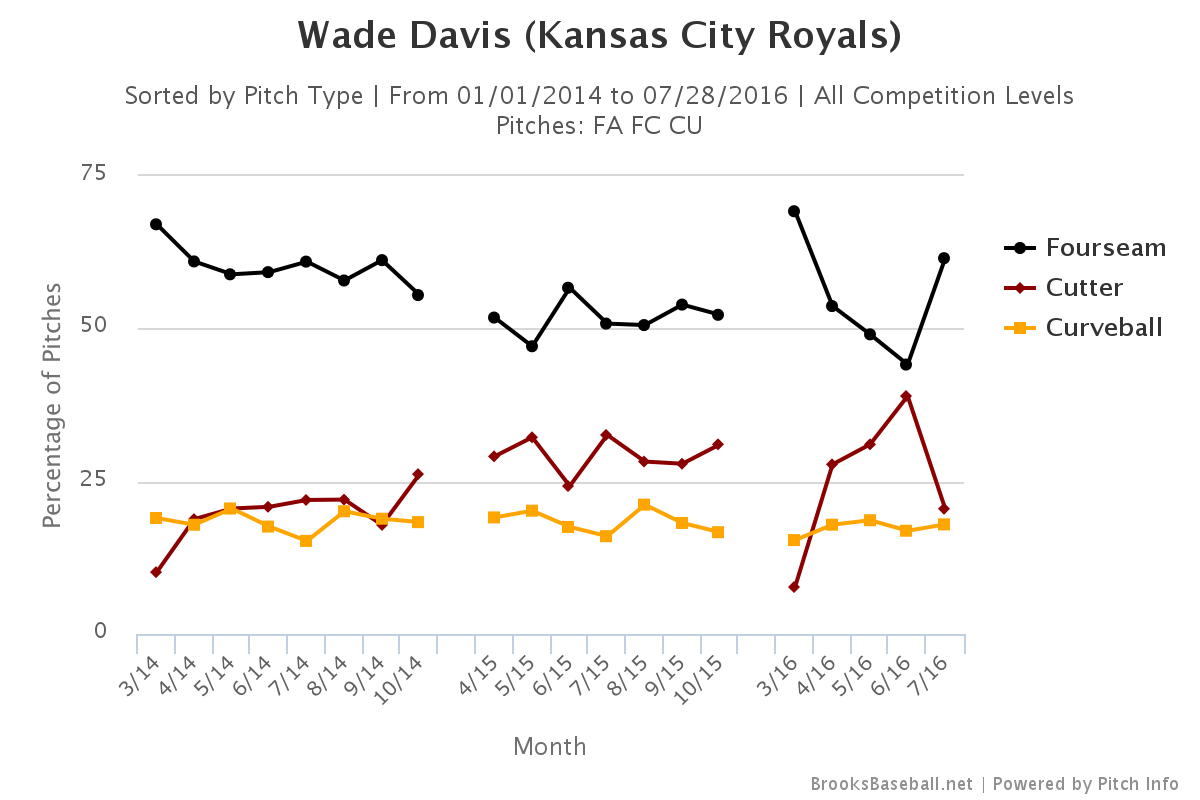It's safe to say the World Series title defense is not going as hoped for the Royals this season. With seven losses in their last 10 games, Kansas City is 49-51 on the season and 6 1/2 games out of a postseason spot. There's even been talk of the Royals selling at the deadline.
If the Royals do decide to pull the plug on 2016 and sell, arguably their most attractive trade chip is closer Wade Davis, who owns a 1.09 ERA (380 ERA+) with a 0.87 WHIP and a 219/58 K/BB in 173 innings since moving into the bullpen full-time in 2014. He also allowed just one earned run in 25 postseason innings from 2014-15.
The Yankees just received a massive four-player haul for Aroldis Chapman and it stands to reason the 30-year-old Davis could fetch even more because his contract includes a $10 million option for 2017. Chapman will be a free agent this winter. That extra year of control with Davis is huge. The Royals can and should place a high price tag on their ninth inning man.
It's no surprise then that many teams have already been connected to Davis in the days leading up to Monday's trade deadline. Will someone make a good enough offer to pry him loose? We're just going to have to wait and see. Either way, Davis carries some red flag this season, which may give teams pause before considering a trade. There are four big red flags, in fact.

1. His strikeout and walk numbers have taken big steps back
When you look at the numbers, you'll see Davis has a 1.60 ERA (280 ERA+) and is 21 for 23 in save chances. That's really good! At the end of the day, his job is to prevent runs and rack up saves, and Davis is doing exactly that.
Under the hook is where you can see the more troubling trends, specifically a rather drastic decline in Davis' strikeout and walk rates. Check it out:
| Strikeout Rate | Walk Rate | |
| 2014 | 39.1% | 8.2% |
| 2015 | 31.1% | 8.0% |
| 2016 | 23.7% | 11.1% |
The average strikeout and walk rates for relievers this season are 22.6 percent and 8.8 percent, respectively. Davis' strikeout rate from 2014-15 was far, far better than average. His walk rate was a touch better than average too. This year his strikeout rate is essentially average while his walk rate is higher than average.
For whatever reason, Davis isn't missing as many bats or throwing as many strikes in 2016 as he did from 2014-15. The ERA and save rate are great, yet he's having to work a little harder to put batters away this year.
2. Davis has stopped throwing his cutter
Like most pitchers Davis simplified his repertoire when he moved to the bullpen. He threw five and sometimes even six pitches regularly as a starter, but, in relief, he is primarily a fastball/cutter/curveball pitcher. The cut-fastball is a buzz saw that chews up lefty batters inside.
This month Davis has scaled back on his cutter usage, rather severely too. Here's his month-by-month pitch usage via Brooks Baseball:

That's a pretty big drop this month! That's more than the usual month-to-month fluctuation we see from every pitcher throughout the season. Davis has shelved his cutter, and when a pitcher suddenly begins steering clear of one pitch like that, it suggests he's lost feel for it and/or isn't confident throwing it.
3. His command has not been good
Command is a tricky thing to define. Control is the general ability to throw strikes. Command is the ability to throw quality strikes, meaning paint the corners and dot the bottom of the zone, that sort of thing. Most pitchers can throw a fastball down the middle for a strike when they need to. How many can hit the inside corner for a called strike? Not many.
Walk rate is a control stat. That's basically balls vs. strikes. Davis' sudden increase in walk rate this season suggests his control is off. But what about his command? He's throwing fewer strikes in general. Is he also throwing fewer quality strikes?
To answer this question, we can turn to Baseball Info Solutions' Command Charting data. The information is recorded by human stringers who track how close each pitch was to the intended target, meaning the catcher's glove. Here is Davis' command data during his three years as a reliever with Kansas City:
| Closest to Mitt | Close to Mitt | Far from Mitt | Farthest from Mitt | |
| 2014 | 23% | 31% | 25% | 31% |
| 2015 | 25% | 24% | 26% | 25% |
| 2016 | 16% | 20% | 26% | 39% |
Theoretically, the league average pitcher has average command, meaning 25 percent across the board in those four buckets. Davis' command was almost exactly average last season. It's hard to get any closer than average, really.
This year though, Davis is rarely hitting his catcher's glove ("closest to mitt") and is often missing his target by a significant margin ("farthest from mitt"). This data is record by humans, not radar like PitchFX, so there will be some scorer bias. Still, Davis' command this year has not been nearly as good as it was just last season. He's missing his target consistently and not by a little bit either.
4. Davis missed time with a forearm strain
This is a pretty big one, and guess what? It could explain all that other stuff I just talked about. The decline in strikeout and walk rate, the shelving of the cutter, and the loss of command. Davis was out from June 30 to July 16 with a forearm strain, two of the most dreaded words in baseball.
Forearm strains are a common precursor to Tommy John surgery, though not always. Andrew Miller missed a month with a forearm injury last season and has been perfectly healthy (and overwhelmingly dominant) ever since. The forearm strain does not automatically mean Davis is heading for Tommy John surgery soon. It does indicate there was something wrong with his pitching arm earlier this month though, and that's kind of scary.
The Counterpoint
The counterpoint to everything you see above is this: he's still Wade Davis. Davis was arguably the most dominant reliever in baseball from 2014-15, and even his "down" year this season has been fantastic. Teams are still going to want him and I'm sure many clubs are still willing to pay big to get him. Big enough to pry him loose? We'll see.
That all said, there are some red flags here that, if nothing else, interested teams should be aware of. They'll be taking on some risk. The forearm strain is worrisome, as is the decline in strikeout rate, walk rate, command, and cutter usage. Few pitchers in baseball are as dominant as Davis when he's healthy and right. Is he healthy and righty at the moment? The data suggests he may not be.


















